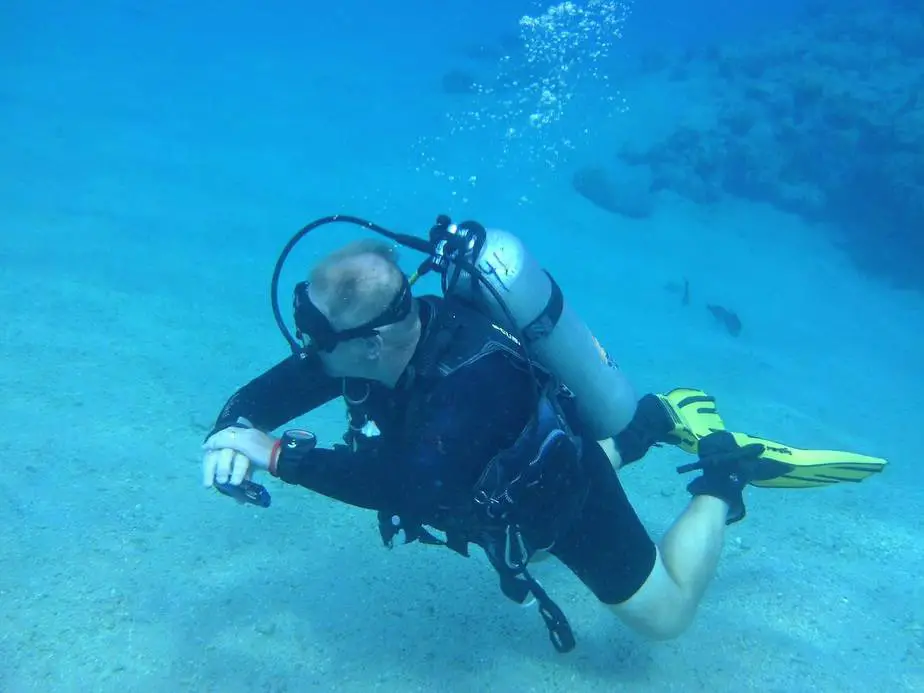Scuba diving for a long time is fun, right? Also, deep diving is fun as well, right? Wouldn’t it be amazing if we could dive for as deep and as long as possible? Unfortunately, these goals are at ends with each other, and the reality is that there is a limit to how deep and long you can stay underwater. While there are various factors that can affect how long a scuba tank can last, one factor that you cannot change is that the deeper you go, the faster your air supply will deplete.
Why do divers use up air faster at depth? The reason is due to Boyle’s Law. When you’re underwater, you (and your breathing gas) are subjected to immense pressure. Since your regulator needs to supply you with air that matches the surrounding water pressure, it will give you much denser air to breathe. This means that each breath at a deep depth can easily be worth the equivalent of 2 or 3 breaths (or more) at a shallower depth. This is something you cannot control, however what you can affect is how efficiently you use up your energy underwater which affects your air consumption rate.
If all of this sounds confusing to you, we will explain it in more detail below. In this article, we’ll discuss why divers use more air at depth, ways to dive deeper for longer, and also how to manage the factors that you can control to increase your bottom times.
Why do divers use more air at deeper depths?
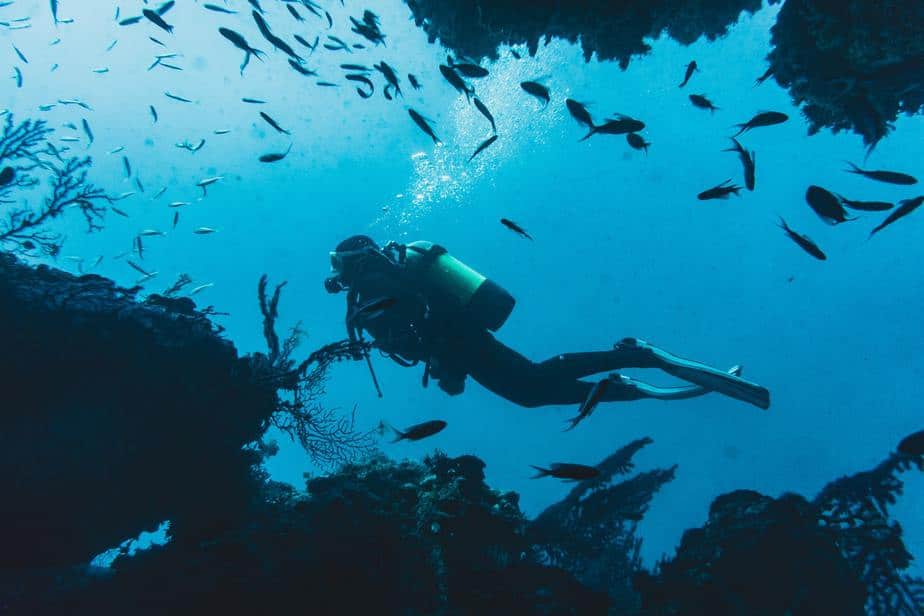
To explain this, we need some contextual information first. When we are at the surface, as we normally are, we are technically under some pressure because even air weighs something. It’s not something we think about because this is our “normal”, but yes, air is weighing down on you. All of the air in the world from between sea level and space adds up. With this as our reference point, we say that the pressure air exerts at sea level (0 m) is 1 atmosphere (1 ATA).
This distinction is important, because as you’ll learn, at an elevation higher than 0 m, air gets lighter therefore the pressure decreases. What we’re focused on is what happens to how much pressure when we’re subjected to the immense water pressure at various depths underwater. Water weighs a lot more than air, so the pressure adds up quickly.
Another point of reference you should know is that for every 10 m / 33 ft underwater, the pressure increases by 1 atmosphere (ATA).
So if we start off at 1 ATA at the surface, at a depth of 10 m, the pressure has increased to 2 ATA. At a depth of 20 m, the pressure is now 3 ATA, and so on.
How does this affect our body? Since our bodies contain mostly liquid, and the pressure does not compress liquids, we do not have to worry about being crushed to death underwater (at least, not at the depths a scuba diver can reach).
With that said, our body’s air spaces will certainly be affected by the water pressure and get compressed, particularly the lungs. This can be an issue if we don’t do something about it. However, the fact that gases can be compressed is generally a good thing, because how else could our scuba tank fit so much air into it in the first place?
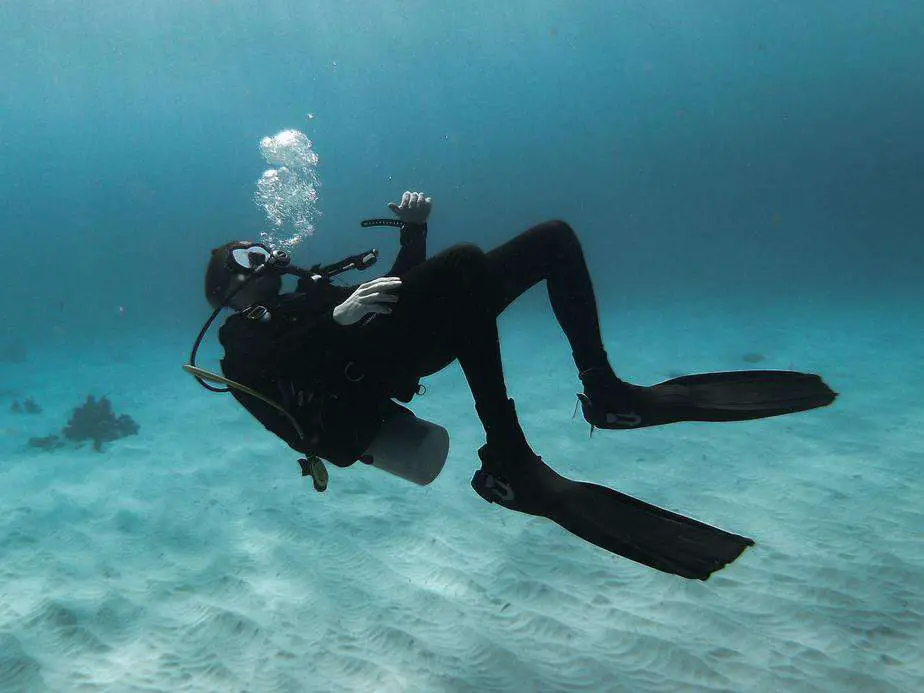
Continuing on, pressure can affect a gas’ volume (how much space it takes up) and density (how close the molecules are together). For instance, if pressure is applied to a gas in a sealed environment such as a balloon, you’ll notice its volume decreases as its density increases.
In the same way, the volume of air in our lungs (and the lungs themselves) would continuously get smaller as the pressure increases and the density increases. If we were to try to breathe air at a lower pressure (e.g. air from the surface), the water pressure around us would not let our lungs inhale.
For this reason, this beautiful invention called the scuba regulator takes the compressed air stored in the tank and delivers it to us at a pressure matching the surrounding pressure (ambient pressure) so that we can breathe underwater. Since this air is highly pressurized, our lung volume will remain the same, and the air we breathe will be much denser.
All of this is a long-winded way of saying that the deeper you go, the denser the air you breathe will be, so you are inhaling more air molecules per breath.
How much does the water pressure affect the total air supply at depth? Good question.
A standard 80 cubic feet tank is typically filled with air that has been compressed to 3,000 pounds per square inch (PSI) or about 200 ATA. Even though the internal volume of a tank is 0.39 cubic feet, when the air has been compressed this much, a scuba tank of this size can store approximately 2,200 L of air at the surface.
However, remember that the regulator gives you the air at a pressure equivalent to the ambient pressure. Say you are at a depth of 20 m underwater, so you are under 3 ATA of pressure. The regulator would give you air that has been compressed three times more than usual, or you could say the air is 3x denser than normal.
That means that at a depth of 20 m, your cylinder will only last about a third as long as usual. At 30 m, it will only last a quarter as long as usual, and so on.
Does my body need the extra air?
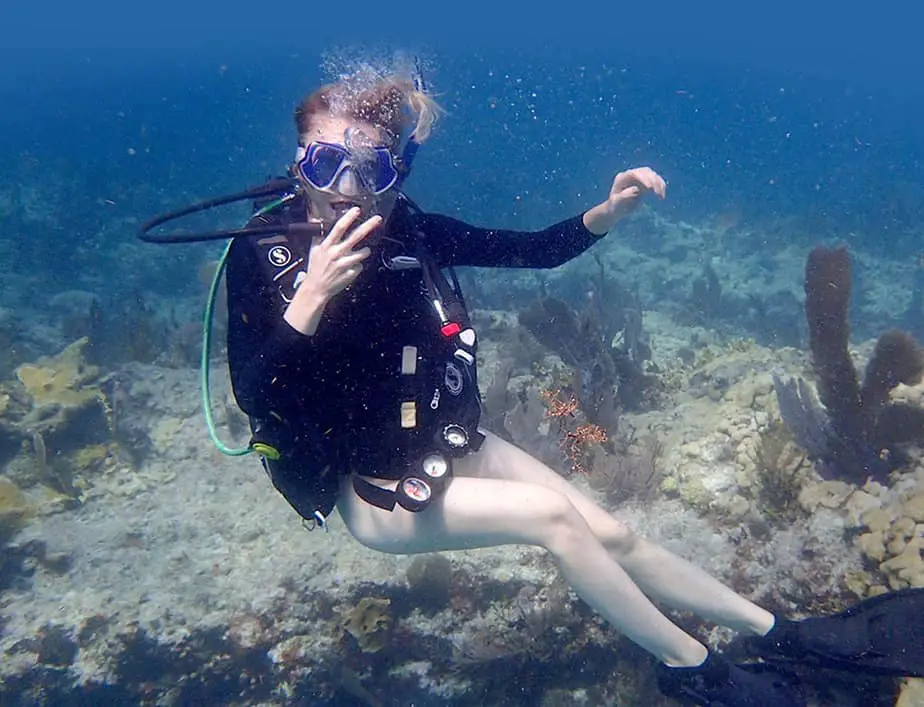
Normal surface air is composed of 21% oxygen, and 79% nitrogen. We specifically need the oxygen in the air for our body’s functions and more. For instance, our body needs oxygen to convert the food we’ve eaten into usable energy, and this process is called metabolism.
With that said, our lungs only use some of the oxygen from air, and carbon dioxide is added to the mix as a waste product. The air we exhale is something like 16% oxygen, 79% nitrogen, and 4% carbon dioxide.
As you can see, the nitrogen percentage remains the same but the oxygen percentage decreases, and carbon dioxide is now present. This is because our bodies do not use nitrogen in the air. Even underwater, the percentage of nitrogen will remain the same.
It’s not that our lungs need the extra air when we breathe underwater, but we need to breathe the same volume of air underwater as on the surface. Unfortunately, the air underwater will be much denser, meaning more of it is being inhaled each breath, causing our air supply to be used up faster.
Each breath we take underwater will have more oxygen molecules per breath. Some people mistakenly believe that we can take fewer breaths per minute since we are taking in so much more oxygen than normal.
There are a few problems with that logic. One is that you should never hold your breath while scuba diving.
The second problem is that our blood has a limit to how much oxygen it can take before it becomes saturated. Therefore, just because we have more oxygen molecules available due to the denser air we breathe doesn’t mean that our bodies can utilize all of it.
The third problem is that our breathing reflex is controlled by how much carbon dioxide there is in our blood, not how much oxygen is in our blood. As long as there is sufficient CO2 present, our urge to exhale will become overwhelming no matter how much oxygen we have.
So it’s not that our bodies need more air underwater; rather, we need to breathe at the same volume and our breathing reflex causes us to use our air supply faster the deeper we dive.
How come partial pressure of oxygen (PPO2) increases with depth?
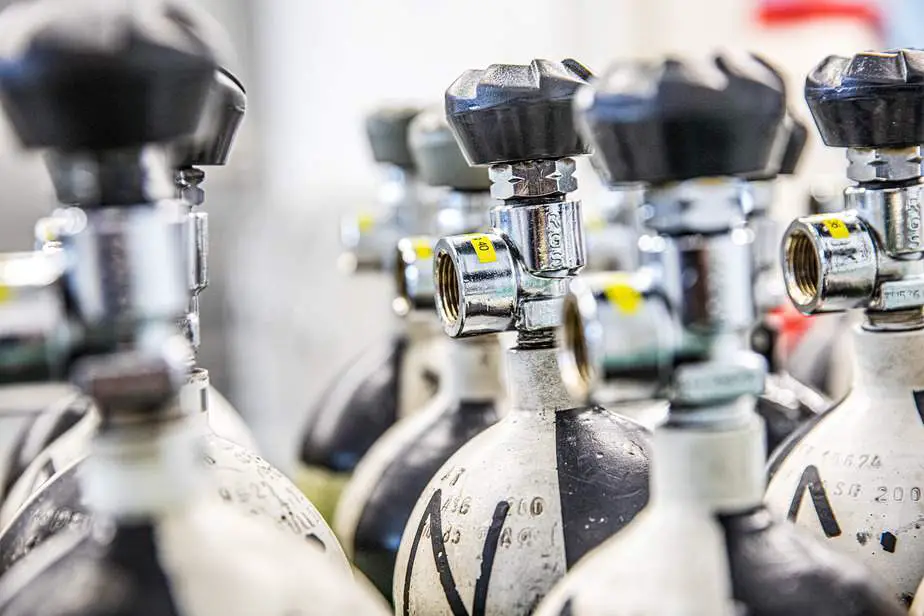
As we mentioned, air is a mix of many gases. We simplified it by saying it’s 21% oxygen and 79% nitrogen. Technically, it’s more like 78% nitrogen, and 1% trace amounts of other gases such as argon, carbon dioxide, neon, helium, hydrogen, xenon, krypton, and carbon monoxide.
When referring to mixed gas pressure, the partial pressure is describing the individual pressure that each gas within it has. So going back to oxygen, it is 21% of air. This means that oxygen comprises 21% of the total surface pressure of air at 1 ATA. We can say that the partial pressure of oxygen at the surface is 0.21 ATA.
As you dive deeper underwater, the total pressure of air will increase proportionally, therefore the partial pressure of oxygen will increase proportionally.
Again, every 10 m of depth underwater increases the pressure by another atmosphere. So at 10 m underwater, the partial pressure of oxygen (PPO2) is 0.42, since there is 2 ATA of pressure at that depth. At 40 m underwater, the PPO2 is 1.05, and so on.
When we have too much oxygen in our system, divers can experience oxygen toxicity. This is the reason why divers don’t breathe pure oxygen when diving. Even using regular air or other gas mixes, due to how dense the gases become at depth, oxygen toxicity can start to become a problem if the PPO2 exceeds 1.40. This can occur at a depth of 55 m / 180 ft.
Will a different gas mix decrease gas consumption rate?
Since our breathing reflex is controlled by how much carbon dioxide is accumulating, and this cannot be stopped because it’s a waste product of metabolism, then it doesn’t really matter what gas mix we use.
CO2 will continue to build up whether we are breathing air, nitrox, or trimix, so gas consumption will not change at all if the only change is in the gas mix used. If one wishes to increase their bottom time when diving, one should focus on things like breathing in deeply and slowly, improving their finning technique and buoyancy control, not using their arms to swim, and so on.
Does my equipment affect my air usage at depth?
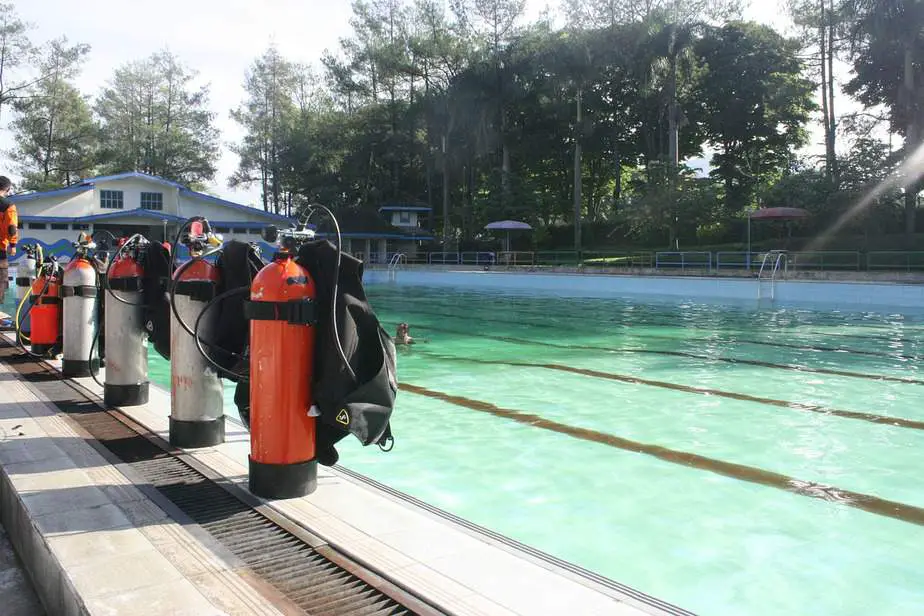
Very much so. After all, is it not the regulator that controls how much air gets fed to you? If there were any problems with it, such as a leak, then you will be wasting air extremely quickly.
Assuming no malfunctions with your gear, then the next piece of equipment to worry about is your BCD. You need to add or remove air from the BCD to compensate for changes in buoyancy as you dive. As you dive deeper, due to the decreasing volume of air inside, you must add more air into your BCD to compensate.
How much air you need to fill your BCD with depends on how heavy/buoyant your gear is. If you are wearing a thick exposure suit, the air bubbles trapped inside means that you will be exceptionally buoyant. To compensate, you need to wear more dive weights to begin your descent, but that means more air must be added to compensate for your weight at depth.
If you use too much dive weight, then you are wasting air to compensate for weight you didn’t need in the first place.
Additionally, how bulky your equipment is can increase your drag, which is water resistance underwater. You need to streamline your setup so that you won’t feel like you’re swimming with a parachute behind you. Many divers prefer to dive sidemount which has less drag and allows them to fit into tighter spaces.
Can I calculate my surface air consumption rate (SAC) at depth?
Yes, you can estimate how much air you’ll use at your maximum depth, but first you’ll need to do a test underwater.
Once you know how much air you typically use at a given depth, you can then calculate how much air you’d use at any depth.
We recommend doing your air consumption test at a depth of 10 m / 33 ft. Do what you would normally do while scuba diving for 10 minutes. Don’t do anything that would exert you too much physically, and don’t just go limp to conserve all of your energy; both of these scenarios would produce inaccurate results.
By comparing how much air you started with and then subtracting that number from how much air is remaining after your 10 minute dive, the result is how many PSI or Bar you used in that time.
Divide this number by 10 since you swam for 10 minutes, and you now know how much tank pressure you breathed per minute at 10 m of depth. Then divide this by 2 (because at a depth of 10 m, the pressure is 2 ATA), and now you have your surface air consumption.
Again, it’s much more accurate to perform this test at 10 m / 33 ft underwater rather than just breathing from your air tank at the surface because it needs to factor in your actual scuba activity which can increase your breathing rate.
Once you have your actual SAC, let’s say it is 30 PSI / 2 bar per minute, then calculating your air consumption at various depths is much easier. If you were to dive to 20 m / 66 ft, where the pressure is 3 ATA, then you can expect to use 90 PSI / 6 bar per minute (we multiply your SAC by 3 since the air would be 3 times denser at that pressure).
Keep in mind, these calculations are assuming that you are using the same tank for your dives and perform similarly during each dive. If you drastically change up your routine, then the calculations will become more and more inaccurate.
With that said, nowadays divers can use their dive computer to perform these calculations in real-time. Dive computers can account for fluctuations in air consumption and warn you when it’s time to surface. You can still manually calculate your air consumption rate at depth so you have a reference point, but dive computers can give you more accurate information.
Do I need bigger and more tanks for deeper dives?
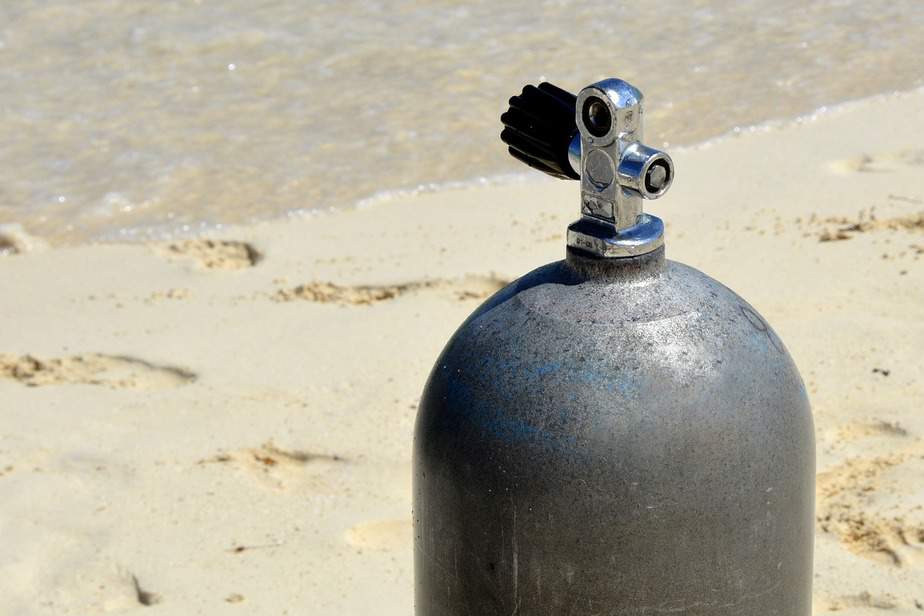
Technically, yes. However in practice, this is not necessarily the case. If you are a recreational diver, the factors most likely to end your dive are air consumption and the no-decompression limit.
We’ve already discussed how the air you breathe becomes much denser due to the high pressure at deep depths. You could easily end up using your air 3-4 times faster than at a shallower depth. The solution at first glance would be to simply bring more tanks, or a bigger tank, so that you have more air to work with.
However, this is ignoring the other problem which is your no-decompression limit. According to the PADI Dive Table, your no-decompression limit at a depth of 40 m / 130 ft is only 8 minutes. Therefore, unless you are a technical diver and have planned for a decompression dive (if you’re asking why divers use more air at depth, you’re not there yet), you will reach your NDL irrespective of how much air you bring.
If you want to dive deeper and longer and exceed your NDL, then you need to learn about diving trimix and diving CCR. These are both highly advanced, technical diving methods that are beyond the scope of this article.
How to use less air at depth
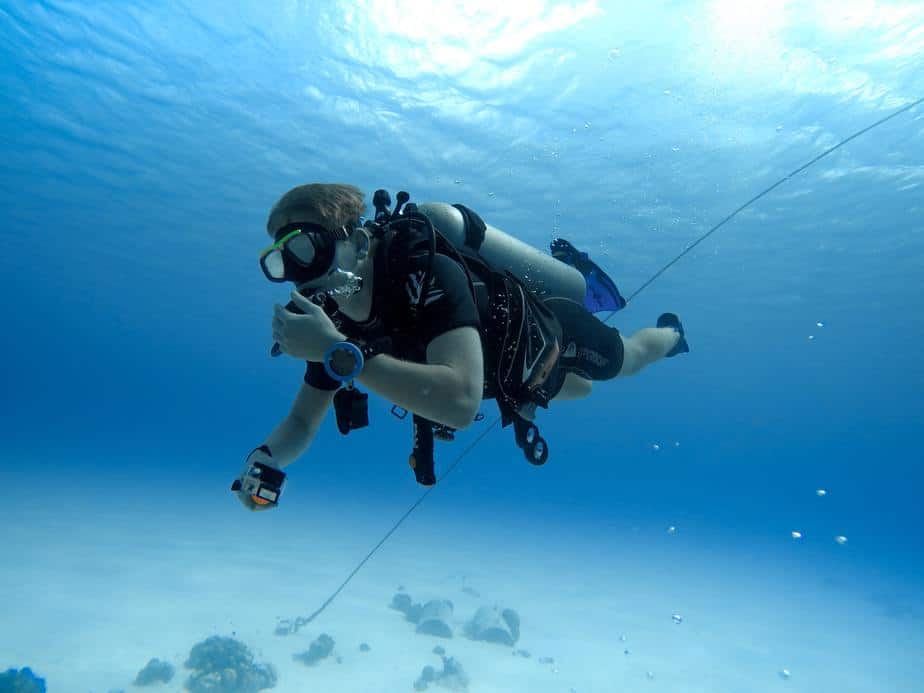
While you cannot change the fact that you will use more air at depth because the air will be much denser, you can change other factors like your behavior. In fact, there are a number of ways you can improve air consumption underwater both in and out of the water which we’ll discuss now.
Before you dive
There are a few things you should do before a dive; most of them would fall under “common sense”, but some of them are a little unintuitive.
Have a good night’s rest, at least 8 hours. Don’t drink alcohol before you dive, or even the night before a dive because you may still be impaired in the morning.
Don’t dive on an empty stomach, but don’t eat too much either. Eat a light meal 2-3 hours before diving. Don’t eat a large meal because you will feel extremely bloated, lethargic, and might vomit during the dive.
Also, stay well hydrated. Some divers actually hold back on their water consumption because they don’t want to pee during their dive. Thankfully, it’s perfectly normal to pee in your wetsuit. It won’t damage your suit and the pee will mix with the water and get flushed out anyways. Don’t feel grossed out; what do you think the fish and other people do in the water?
Also, what do you think closed-circuit technical divers do when they are diving for hours at a time? They dive for so long that they are forced to eat and drink while underwater.
Another thing – if you’re feeling drowsy, avoid drinking coffee or tea. Like alcohol, they are diuretics, meaning they increase urine production and make you want to pee. Yes, peeing underwater is fine, but the problem here is that you will be peeing too much. It will cause you to lose more fluid than you gain from drinking these beverages. This can potentially cause dehydration during a dive.
To sum it up: get plenty of rest, stay hydrated, eat enough food so that you don’t feel hungry, avoid alcohol and any drinks containing caffeine. Being well-rested and healthy will help divers stay relaxed and focused, and this directly affects how much air they will consume underwater.
What to do underwater
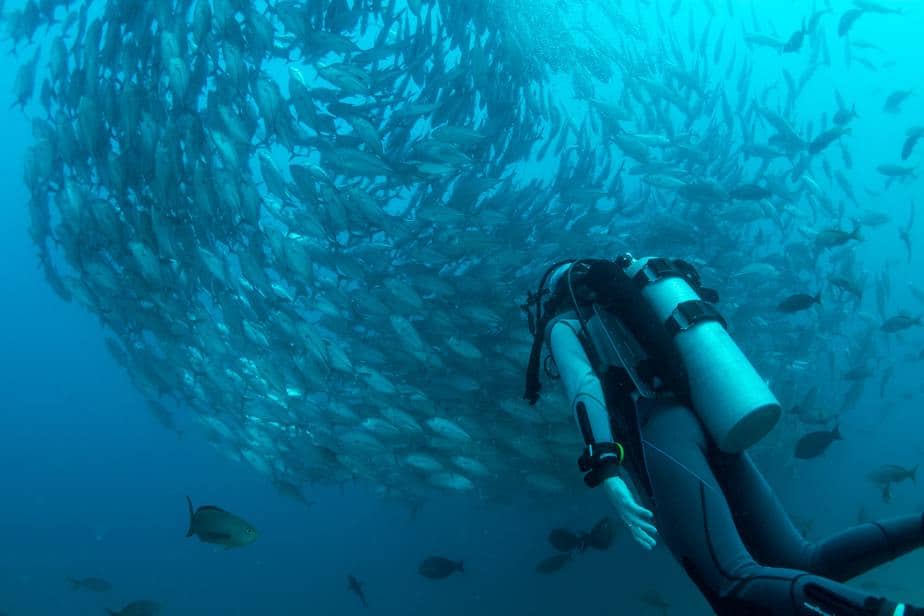
The advice provided in this section is crucial, as it involves things that you should do every time you go scuba diving. It includes how to breathe and how to use your arms and legs the right way.
Breathe deeply and slowly. Anyone who thinks that rapid breathing or holding one’s breath will help is dead wrong. Deep and slow breathing ensures that you’re getting enough air in your lungs and that it has enough time to take sufficient oxygen from the air before you exhale. Rapid breathing will waste a lot of air. Holding your breath can potentially cause your lungs to rupture as the air inside expands.
Try not to use your arms. If you have a background in swimming where arms are important for propelling yourself forward, this is something you’ll have to condition yourself NOT to do. That’s what fins are for. Your arms should only be used for communicating, adjusting equipment, holding a camera or things of that nature. Do not use them to help you swim because it is a waste of energy. Using up energy unnecessarily will speed up your air consumption rate.
Use your legs and fins. As we mentioned above, keep your arms folded and let your legs and fins do the work instead. Fins make your kicks generate more thrust and propulsion, and the energy expenditure when finning is much more worth it than using your arms. The best kick you can do is the frog kick. With that said, too much finning is also a waste of energy. Fin only when needed. Go as slowly as possible and basically try not to move unless needed. Lazy divers have the longest bottom time. It gives you time to slow down, chill out, and take in the sights while minimizing air consumption.
Relax. This might sound like some new age mumbo-jumbo, but what is going on in a diver’s mind makes a big impact on their air consumption. Think about it. A diver who is anxious, worried, or outright scared will probably have a higher heart rate than one who is cool as a cucumber. To be fair, there is a lot to worry about while diving, but if you’re overly worried, you can lose your concentration, breathe more rapidly, have a higher heart rate, and so on. These are all conducive to using up your air faster.
Stay warm. You need to wear the appropriate exposure suit for the water you’re diving in. Many people are blindsided by how cold freshwater is compared to saltwater. One’s ability to stay warm will affect how much air is consumed. We’re warm-blooded mammals, and when we’re cold, our body will use more energy to try to stay warm. If you’re shivering, then you can expect your dive to end much faster (you’re also at risk of hypothermia, so beware).
How dive equipment affects your bottom time
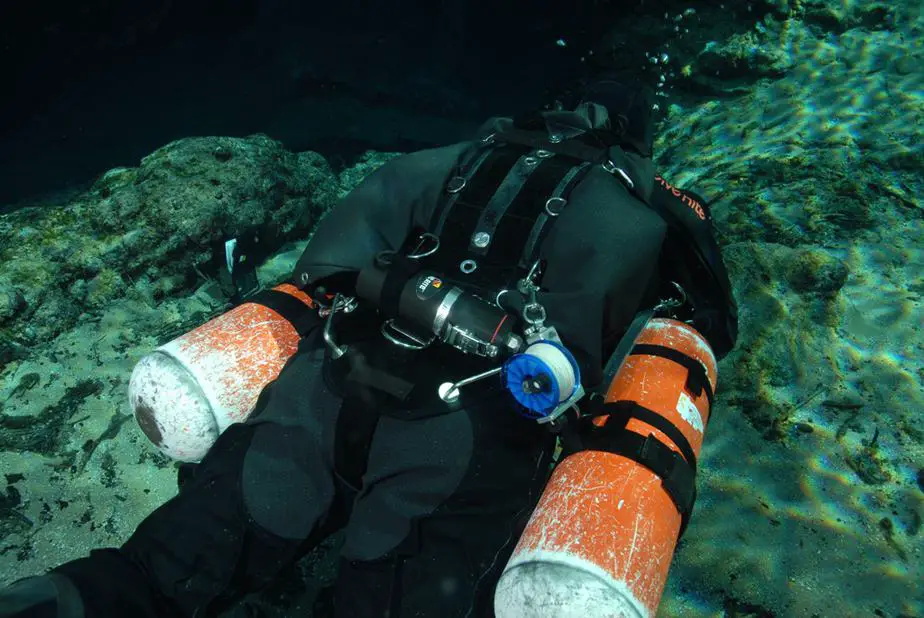
Many recreational scuba divers don’t dive enough to justify purchasing their own gear, so they’ll rent it from a dive shop. However, this opens you up to possible risks like gear not fitting you properly, using equipment that hasn’t been properly maintained, more drag underwater, or even malfunctioning equipment.
Also, weighting yourself can become an issue if you have to do it each time. There’s a possibility your gear is too heavy, so you require more air to reach neutral buoyancy. On the other hand, if you’re too buoyant and are fighting to stay down, then that is also a colossal waste of energy.
When divers use the same gear and dive weights each time, it’s much easier for them to make small adjustments. Divers can find the “perfect” weight balance for them after multiple dives. Or they can eventually realize that removing a weight helps them dive just as easily and safely.
Divers need to be somewhat negatively buoyant (overweighted) so that they can begin their descent. However, many people overestimate this and bring too many dive weights. Look at your dive guide to get an idea of how much they are using – probably 2 kg or less. Being properly weighted can affect your air consumption rate as it relates to filling your BCD to manage your buoyancy.
Also, things like the fins you’re using, their size and weight specifically, can affect how much effort you need to put in for a good kick. A good pair of fins can help you reduce energy consumption by 20%. Try to streamline your setup by diving sidemount or using less bulky equipment to improve how efficiently you can fin.
We are also assuming that your scuba tank, regulator, dive computer, and pressure gauge are all working fine. If there is a leak, or your gauges/screens are showing you the wrong information, it can definitely cause a dive to end much sooner than anticipated.
How other’s behavior can affect your air consumption
Typically, other’s behavior in a group would only affect the length of your dive and nothing to do with your air consumption. However, the outcome is the same – you have to end your dive earlier.
There are some instances where another diver’s behavior can cause you to use up air faster. For instance, if someone is messing around, behaving in a funny, entertaining, and possibly foolish way, then that might be fun for a while. However, if you’re laughing or joining in on the tomfoolery, then you will use up air faster.
Also, in extreme cases, you may need to let your dive buddy borrow your octopus (spare hose) so that you can both ascend together safely. This too will end your dive very quickly.
Parting words
To sum it up, divers use more air at depth because the water pressure makes it impossible to breathe unless your regulator also provides you with air at the ambient pressure. This means that divers will be breathing much denser air at depth, causing their scuba tank to be used up multiple times faster than at shallower depths. This is an unavoidable fact.
However, there are still little tweaks divers can make that can affect their air consumption rate at depth. Things like not using their arms, using only their fins to move, getting better at their finning technique, being better at managing buoyancy, staying calm, breathing deeply and slowly, and many more tweaks they can do.
The most important factor that affects air consumption rate at depth is experience. Divers who have more experience are more likely to stay calm, relaxed, and to be more efficient with their movement than someone less experienced. By following the tips provided in this article, you can maximize your bottom time even if the air you breath is denser.

